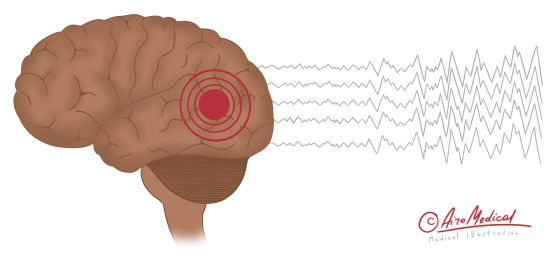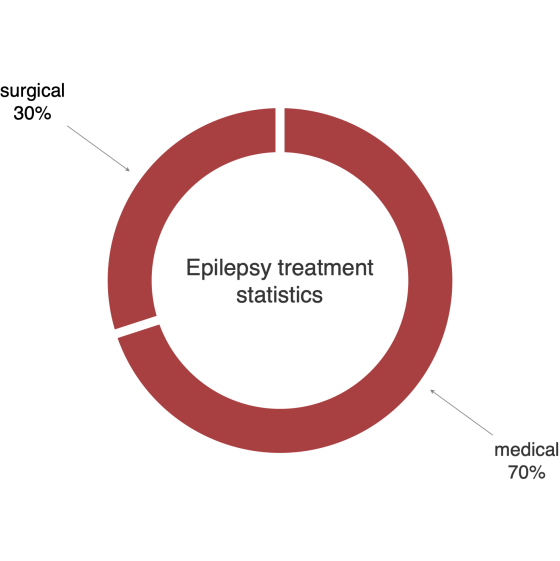Da Vinci Prostatectomy Prostate Cancer Treatment

70% of people with epilepsy can stop having seizures by taking medications.
About 1 in 26 people will have epilepsy at some point during their lifetime.
A sudden death (SUDEP) kills one out of 1,000 epilepsy patients yearly.
1 in 3 people with epilepsy can not control their seizures with medication.
 What is epilepsy, and how it affects people's lives?
What is epilepsy, and how it affects people's lives?
Epilepsy is sometimes called a "convulsive disorder," a broad term for a group of brain diseases that cause repeated seizures.
A seizure is an unexpected increase in the brain's electrical activity, making it hard for brain cells to "talk" to each other. It is a short-term change in how the brain usually works. An individual's seizure depends on what part and how much of the electrical disorder impacts the brain.
 To the question of how to diagnose seizures, we have to notice that an episode can look different. It can be a blank stare, uncontrollable movements, change in awareness, strange feelings, or convulsions. Sometimes, it seems like a person is staring, which causes them to fall, shake, and lose track of what's happening around them.
To the question of how to diagnose seizures, we have to notice that an episode can look different. It can be a blank stare, uncontrollable movements, change in awareness, strange feelings, or convulsions. Sometimes, it seems like a person is staring, which causes them to fall, shake, and lose track of what's happening around them.
In this neurological disease, the brain starts to work strangely, which can lead to attacks and other strange feelings or behaviors. Sometimes people lose consciousness. Usually, seizures are short and can last between a few seconds to a few minutes.
One of the national surveys asked people with epilepsy what problems they faced daily besides having seizures. The top three issues were:
- a lack of independence, such as being unable to drive;
- a negative effect on social life, stigma, and marginalization;
- lack of awareness.
These show that seizures can affect daily life beyond health problems, so need epilepsy treatments.
 What are the causes of epilepsy?
What are the causes of epilepsy?
Anyone can develop epilepsy. This disease affects men and women of all races, nationalities, and ages. Scientists say that 65 million people in the world have epilepsy diagnoses. More than 150,000 people are told they have epilepsy every year.
Different things cause each person's seizures. About half of the people with epilepsy don't know what caused it. Doctors can sometimes relate epilepsy to genes, head injuries, autoimmune conditions, metabolic disorders, or infectious diseases. Each case has different symptoms, ways how to diagnose epilepsy, and methods to treat it.
 What are risk factors?
What are risk factors?
A risk factor makes an individual more often have seizures or epilepsy. Risk factors can sometimes cause scar tissue in the brain or cause the brain's parts not to develop or work correctly.
Widely known risk factors are:
- Babies who are too small for their age at birth
- When babies have seizures in their first month of life,
- When a baby is born with parts of the brain that aren't right,
- When blood gets into the brain,
- Brain blood vessels that don't work right,
- Severe damage to the brain or not enough oxygen to the brain,
- Brain infections: abscess, meningitis, and encephalitis,
- Stroke is caused by arteries getting clogged,
- Cerebral palsy,
- Intellectual and developmental disabilities,
- When seizures happen within a few days of a head injury ("early posttraumatic seizures"),
- A history of epilepsy or seizures caused by fever in the family,
- Alzheimer's disease (late in the illness),
- Disorders on the autism spectrum,
- Prolonged seizures caused by a fever (called febrile seizures),
- Cocaine use and other illegal drug use.
Mild head injuries, like a concussion with a very short loss of consciousness, do not cause epilepsy. Still, no one knows what happens to a person with epilepsy when they have multiple minor head injuries.
What if none of those things apply to you?
Even though the disorders and injuries on these lists help explain many cases of epilepsy, most people with that disorder don't have any. We don't always know how or why someone starts having seizures.
 What makes someone have a seizure?
What makes someone have a seizure?
Even if you don't know what caused yours, epilepsy needs treatment. And you can look to see if t things that cause seizures to avoid them. These things are often called "triggers."
When these things happen, a person with epilepsy may be more likely to have convulsion episodes. The triggers could change how many seizures a person has or how bad they are. If you know your triggers, you can figure out what to do next. People can sometimes learn how to change their lifestyle or environment to make it less likely that they will have an attack.
 How to be diagnosed with epilepsy?
How to be diagnosed with epilepsy?
A neurologist can tell if someone has epilepsy after other doctors have checked them out. Of course, doctors ask about your seizures as much as possible. They'll also ask you about them, your general health, and your medical history.
Suppose you ask how epilepsy is diagnosed precisely. In that case, the answer is: the doctor compares the patient's test results to those set by the International League Against Epilepsy (ILAE):
- Electroencephalogram (EEG): EEG is a very useful criterion for determining if someone has epilepsy because it records how the brain's electricity works. Sensors on the patient's head record the brain's electrical activity. One sign is that the brain waves change.
- Computerized tomography (CT) uses X-rays to give the doctor a picture of the patient's brain. So, having a tumor as the cause of epileptic seizures is ruled out. CT scanning is fast and can be done in most places. However, it does not show brain structures like an MRI and is not as good at telling the difference between gray and white matter.
- Magnetic resonance imaging (MRI): can detect abnormalities in brain anatomy. These may induce seizures or be associated with epilepsy — a blood vessel abnormality caused by the initial episode or other issues. In diagnosing epilepsy, MRI helps determine seizure type, if surgery can halt, and lets surgeons plan how much brain tissue to remove.
- Functional MRI (fMRI) examines how the brain responds to speech, movement, and other actions. It is done before the surgery to find out which parts of the brain are working and how they change blood flow and metabolism in certain areas. It happens when those areas are activated.
- MEG (magnetoencephalography) is a way to study epilepsy. It shows how the brain works without hurting the person. It is magnetic source imaging (MSI) when is used along with structural imaging.
- Positron emission tomography (PET): a radioactive drug is injected into a vein in the arm and then builds up in the brain. Scanning can determine what brain area is starting to cause seizures. A PET scan is a test that tells practitioners and their patients more about the way the body's cells work.
- Single-photon emission computerized tomography (SPECT) is a nuclear medicine test measuring blood flow through the brain. The doctor injects a radioactive substance into the arm, and a CT scan is done soon after. The scan shows how bright an area of the brain is based on how much blood moves through it. When the seizure starts, more blood flows to the affected area. So, it can help find the seizure onset zone by showing where more blood flows.
- Blood lab tests are made to diagnose if genes or infections can be a reason for epilepsy seizures.
- Neuropsychological tests: The doctor will check the person's speech, thinking, and memory to see if the epilepsy attacks hurt those parts of the brain.
Where to go for epilepsy treatment?
 Can epilepsy be cured?
Can epilepsy be cured?
Treatments are given to patients based on the kind of seizures they have. There are many ways to treat it, such as:
- Treatment of epilepsy with drugs. There are about 30 anticonvulsants that can cure epilepsy today. However, researchers don't stop trying to make new drugs. If one anticonvulsant drug doesn't work or causes side effects, a doctor will give you a different one that does.
- Changes to the diet. In some cases, if you are looking at how to treat epilepsy successfully, additional measures like a specific ketogenic diet are given after drug treatment is used. The number of attacks can decrease with a diet high in fat, moderate in protein, and low in carbohydrates.
- Surgery: Sometimes, the operation is the only way. In treating epilepsy, doctors stop seizures by removing a part of the brain where the attack is aimed. Even though the goal of treating epilepsy is simple—no seizures and no side effects—finding the right treatment plan can take a few tries.
Modern treatments for epilepsy are still based on anti-seizure medications (ASM). But let's suppose that the first drug doesn't stop seizures (it often happens enough). In that case, the neurologist keeps working with the patient to try other drugs or drug combinations and determine if the patient might be a good candidate for surgery.
Getting control of seizures with minimal side effects through drug treatment usually depends on choosing a drug. It is specific to the type of seizures or epileptic syndrome. Doctors prescribe a few medications and educate the patient and his family to help them follow the dosage schedule. Other things that affect the choice of the drug are possible side effects. It is also essential to determine how complicated or straightforward the dosing plan is. Other factors are the patient’s age, whether or not they can have children, whether or not they take other medications, how they live, and, in some cases, how much the drug costs.
In what places provide the best epilepsy treatment?
 New ways to treat illness
New ways to treat illness
Even though there are a lot of new anticonvulsants, 30% of people diagnosed with epilepsy seizures still have them, along with other health problems and a higher risk of dying. So, modern scientific progress aims to find new ways to treat people without using drugs.
- VNS Therapy, also known as vagus nerve stimulation, changes how brain cells work by sending electrical signals to specific brain areas involved in seizures. The U.S. Food and Drug Administration agrees with the method (FDA). This method is helpful for people who don't know when they might have a seizure.
- The FDA approved Deep Brain Stimulation (DBS) in 2018. A thing that is used to stop seizures. The doctor puts in a device that uses electricity to stimulate brain parts involved in attacks. The device is set up for each patient by doctors specializing in epilepsy.
- Responsive neurostimulation (RNS) is a simulation system that gives direct impulses when an attack is about to start. One or two electrodes placed in epileptic foci monitor brain activity all the time and send an electrical stimulus when a seizure is detected.
- MRI-guided stereotactic laser ablation is a minimally invasive way to destroy brain tissue by heating it precisely. Laser energy is sent to the target tissue through the optical fiber, turning into heat and damaging the cells. MR thermography measures the damage caused by heat in real-time.
Technology in new treatments for epilepsy that is developed to help patients give us hope, and it should keep getting better. Scientists, engineers, and doctors work together to find good ways to get the best results.
Who can help you to treat epilepsy?
 Stats and predictions
Stats and predictions
 Different drugs are being looked into as ways to treat epileptic seizures. As for drug treatment, 70% of people with epilepsy can keep their episodes under control, but for the other 30%, the attacks keep happening even though they are taking the drugs.
Different drugs are being looked into as ways to treat epileptic seizures. As for drug treatment, 70% of people with epilepsy can keep their episodes under control, but for the other 30%, the attacks keep happening even though they are taking the drugs.
Other options like surgery or neurostimulation should be tried in cases of epilepsy that don't respond to medication (this is called drug resistance).
One study from 2016 that was published in the magazine Epilepsia found that young people with epilepsy were 24–28 times more likely to die suddenly and unexpectedly than the rest of the population. Frequent seizures that doctors can't stop are a risk for sudden death, and night cramps are another risk. When anti-seizure medications (ASM) are chosen and used correctly, they can help reduce the number of seizures and the risk.
References:
- Science Direct: Chapter 16 - MRI-Guided Stereotactic Laser Ablation
- CURE Epilepsy: EPILEPSY RESOURCES FOR PATIENTS AND PARENTS
- Frontiers in Neurology: New Trends and Most Promising Therapeutic Strategies for Epilepsy Treatment
- Epilepsy Foundation: Types of epilepsy surgery
- Epilepsy Foundation: How Are Seizures and Epilepsy Diagnosed?
- Karger International: The Epidemiology of Epilepsy
- National Library of Medicine: Prognosis of status epilepticus: role of etiology, age, and consciousness impairment at presentation

















